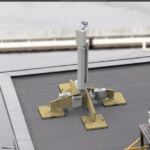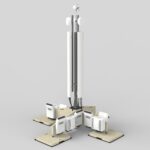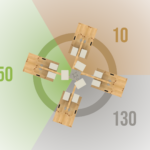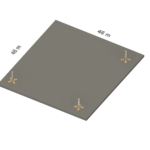Barbican - rooftop cellsites
One truck delivery includes 9 Barbicans. Delivery time is 4-12 weeks from Purchase Order and it takes 10-15 minutes to install one Barbican. Barbican has 24-month guarantee, which is expandable by using Lifecycle Services.
- 1-4 sectors per Barbican
- Certified as CO2 sink – first in the market
- 10 minutes to built or dismantle
- Fully reusable on another location
- Floating structure – no drilling to roof
- Lifetime is +30 years
- Any color, engravings or advertising signs
Barbican is the name for a four-legged pole structure installed on sloping or flat rooftops for mobile network devices and antennas, cameras or other pole-installable things. Barbican structure floats over the surface meaning that it holds its place by its dry weight, fittings weight and friction between the surface and the structure.
The height is 390 – 410 cm due to adjustable legs and the structure self weight is +415 kg. Pressure on the roof is 60-190 kg/m² and the footprint is 4×4 meters.
Note: In a case of over 40 m/s wind pressure an extra attachment can be applied to connect an anchoring wire to the wooden wing element or use some other suitable method for securing the structure.
Radiounits (RRU) and cable boxes are installed with wall-mount brackets on the wings. Antennas, radio links and RRUs are installed on the center pole by customer-defined auxiliary tubes or frames.
Center poles can be round or lattice, it is a customer’s choice.
The starting point is to define sectors or directions where antennas should be pointed at. An example picture is a 3-sector site, sector directions 10, 130 and 250 degrees.
As a structure, the Barbican can hold several tons of weight in kilograms. The precalculated charts are up to 500 kgs of customer equipment weight. The self-weight is +415 kg.
The more weight the more stable the Barbican is.
Barbican’s initial suitability check is easy by using pre-calculated charts and figures of its load-bearing capacity in different circumstances. Knowing two of the parameters, the third can be read from the figures
- Wind zone, country specific (EN 1991-1-4/4.2)
- Antenna and fittings wind area
- Fittings weight kg
In the calculations it is presumed that antennas and RRUs do not cover each other facing to wind, thus the wind area is always the worst-case scenario. Note that units which are installed on wooden wings do not add up to the wind area.
In the chart, the vertical z-axis is the customer’s antenna and device area installed on the Barbican pole in [m²] square meters. On the horizontal y-axis is the total weight of the customer’s fittings and the x-axis is wind zones vb0 meters per second [m/s].
The Chart and Table are for the initial evaluation of Barbican’s suitability in particular locations, further static calculation checking is done during the planning phase.
NOTE National procedures may vary country by country regarding telecom tower structures, and how they are classified by standards. Each country’s procedures must be respected and inspection and maintenance activities are followed based on local regulations.
Barbican inspection is carried out on a yearly basis. Repainting is recommended after 10-15 years. Otherwise structure has no special maintenance compared to ordinary rooftop structures.





